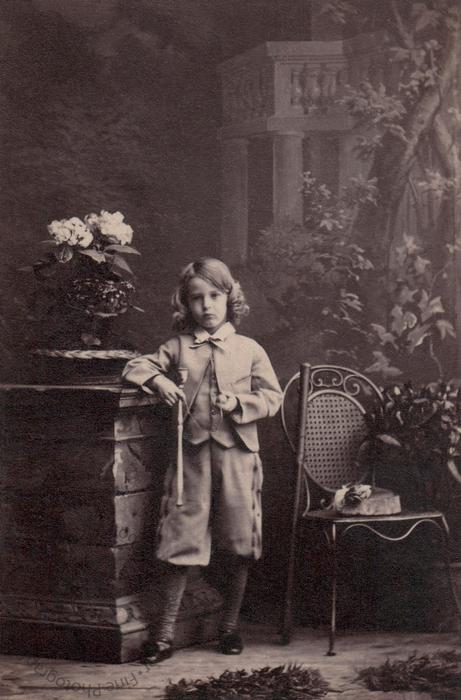Charles Reginald Haines
(1856-1935)
[The portrait does not appear in any of the Silvy daybooks in the archives of the National Portrait Gallery. The sitting probably took place during the period covered by the missing volume (July 1863 to June 1864). The sitter is identified by an inked inscription verso in a fine period hand.]
Born on 27 December 1856 at Byculla, then a residential area for Europeans in Bombay (Mumbai), Charles Reginald Haines was the son of Robert Haines, an army surgeon.
When the 1881 census was taken, he was a 24-year-old ‘Bachelor of Arts’ lodging at 15 Effingham Crescent in Dover.
In 1886 he was the winner of the Maitland prize for graduates of Cambridge University of less than 10 years’ standing. The subject of his essay was ‘General education as a means of propagation of the Gospel’ (Evening Mail, 13 January 1886).
In 1888 he was winner of the Kaye prize, also for Cambridge graduates of less than 10 years’ standing. The subject of this essay was ‘The relations and mutual influences of Christianity and Mahomedanism in Spain during the Caliphate of Cordova, AD 756-1031.’ The value of the prize was about £60 (Cambridge Chronicle and Journal, 9 August 1888).
In 1889 he won the Maitland prize again (it was awarded every three years). The subject of this essay was ‘Mahommedanism as a Missionary Religion’ (Bath Chronicle and Weekly Gazette, 21 March 1889).
At the time of the 1891 census he was the ‘Assistant Master at [a] Public School’ lodging at a house on the High Street in Uppingham, Rutland.
When the census was taken in 1911, Charles was a 54-year-old bachelor living at Pulborough in West Sussex with two servants: a cook and a housemaid. For his profession he gave ‘Student; literateur; lecturer, formerly schoolmaster,’ In red ink he wrote the following across his census form: ‘I wish to record my protest against the omission of Religion due to the pusillanimous subservience of the Government to the Nonconformist minority in this county [sic]. Other countries include Religion in their census, and it is the most important datum of all to discover. This also included in the Irish census where the Anglican religion is in a minority.’ He signed this ‘C.R. Haines, a member of the Anglican Church / Catholic.’
On 7 August 1912, at the age of 55, he married Annie Dorothea Baker, aged 37, daughter of surgeon William Morrant Baker.
‘The residents of Pulborough and district were greatly interested, yesterday, in the marriage of Miss Dorothea Baker, daughter of the late Mr W. Morrant Baker, FRCS, and Mrs Baker, of Nutbourne Manor, Pulborough, to Mr Charles Reginald Haines, MA, FSA, a member of an old Sussex family, he being the son of the late Dr Robert Haines, Principal of the Great Medical College, Bombay, and one of the finest scientific chemists of his day’ (Brighton Argus, 8 August 1912).
The marriage produced a daughter and two sons. In 1921 the family were living at Meadowleigh, 4 Weston Road, Petersfield, Hampshire. Charles described himself as a ‘Public Schoolmaster, retired.’
Charles Reginald Haines died, aged 78, on 4 August 1935 at Meadowleigh in Petersfield. He left an estate valued at £8269.
‘DEATH OF DR HAINES. — The death has occurred at this residence Meadowleigh, Petersfield, of Dr Charles Reginald Haines, DD, MA, FSA, who for many years was a House Master at Uppingham School. He was 78 years of age and had resided in Petersfield for 20 years. He leaves a widow, two sons and one daughter. Dr Haines was a man of marked intellectual attainments and a splendid Latin scholar. He was also a great naturalist and an authority on birds and had written books on those subjects. He was educated at Wellington College and St Catherine’s, Cambridge’ (Portsmouth Evening News, 5 August 1935).
The text of his will was unusual enough for several newspapers to pick up on it. ‘I commend my sinful soul to God who gave it sinless to me […]. Being fully convinced that burial alive is far more common than is usually realised, I strictly charge my heirs, executors and friends, before putting their dead out of their sight, to make the fact of death absolutely certain by means of a post-mortem examination … and I desire that my body should be shrouded in my father’s dressing gown as the mantle of a good and great man … And my wish is that my coffin is to be papier mache, or of the lightest and cheapest deal possible, with iron or steel handles, and by no means of brass …” He desired that his funeral should be as inexpensive as possible, without flowers, and that on the headstone of his grave should be inscribed “He died learning”’ (Hampshire Telegraph, 25 October 1935).
[His brother Robert Lewis Haines (1855-1931) sat for Silvy on 8 July 1865 (Volume 12, page 346, sitting number 16,533). He is identified in the daybooks as ‘Master R.L. Haines.’]

